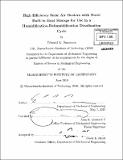| dc.contributor.advisor | John H. Lienhard, V. | en_US |
| dc.contributor.author | Summers, Edward K | en_US |
| dc.contributor.other | Massachusetts Institute of Technology. Dept. of Mechanical Engineering. | en_US |
| dc.date.accessioned | 2011-03-24T20:27:03Z | |
| dc.date.available | 2011-03-24T20:27:03Z | |
| dc.date.copyright | 2010 | en_US |
| dc.date.issued | 2010 | en_US |
| dc.identifier.uri | http://hdl.handle.net/1721.1/61921 | |
| dc.description | Thesis (S.M.)--Massachusetts Institute of Technology, Dept. of Mechanical Engineering, 2010. | en_US |
| dc.description | Cataloged from PDF version of thesis. | en_US |
| dc.description | Includes bibliographical references (p. 129-135). | en_US |
| dc.description.abstract | Compared to solar water heaters, solar air heaters have received relatively little investigation and have resulted in few commercial products. However, in the context of a Humidification-Dehumidification (HD) Desalination cycle air heating offers significant performance gains for the cycle. Solar collectors can be over 40% of an air-heated HDH system's cost, thus design optimization is crucial. Best design practices and sensitivity to material properties for solar air heaters are investigated, and absorber solar absorptivity and glazing transmissivity are found to have the strongest effect on performance. Wind speed is also found to have a significant impact on performance. Additionally a well designed collector includes a double glazing, roughened absorber plates for superior heat transfer to the airstream. A collector in this configuration performs better than current collectors with an efficiency of 58% at a normalized gain of 0.06 K m2/W. Additionally, maintaining a constant air outlet temperature is also important for HD cycle performance. The use of built in phase change material storage (PCM) is found to produce consistent air outlet temperatures throughout the day or night. Using PCM directly below the absorber plate avoids heat transfer inefficiencies by using the working fluid to transfer energy to another storage system. Using a two dimensional finite element model it is found that a PCM layer of 8 cm below the absorber plate is sufficient to produce a consistent output temperature close to the PCM melting temperature with a time-averaged collector efficiency of 35%. However, this efficiency is significantly lower than a collector without storage, indicating a trade-off between efficiency and constant temperature heating, and suggesting alternative forms of energy storage might be more viable. Collectors that can deliver consistent outlet temperatures with good efficiency increase the performance of the HDH cycle. A prototype collector with storage is also built. | en_US |
| dc.description.statementofresponsibility | by Edward K. Summers. | en_US |
| dc.format.extent | 135 p. | en_US |
| dc.language.iso | eng | en_US |
| dc.publisher | Massachusetts Institute of Technology | en_US |
| dc.rights | M.I.T. theses are protected by
copyright. They may be viewed from this source for any purpose, but
reproduction or distribution in any format is prohibited without written
permission. See provided URL for inquiries about permission. | en_US |
| dc.rights.uri | http://dspace.mit.edu/handle/1721.1/7582 | en_US |
| dc.subject | Mechanical Engineering. | en_US |
| dc.title | High efficiency solar air heaters with novel built-in heat storage for use in a humidification-dehumidification desalination cycle | en_US |
| dc.title.alternative | High efficiency solar air heaters with novel built-in heat storage for use in a HD desalination cycle | en_US |
| dc.type | Thesis | en_US |
| dc.description.degree | S.M. | en_US |
| dc.contributor.department | Massachusetts Institute of Technology. Department of Mechanical Engineering | |
| dc.identifier.oclc | 707104841 | en_US |
